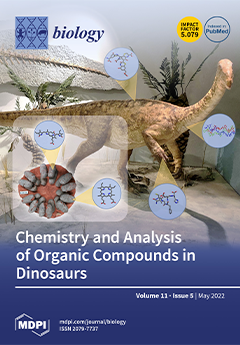Aflatoxin B
1 (AFB
1) is one of the most toxic, naturally occurring carcinogen compounds and is produced by specific strains of fungi. Crop contamination with AFB
1 can cause huge economic losses and serious health problems. Many studies have examined the
[...] Read more.
Aflatoxin B
1 (AFB
1) is one of the most toxic, naturally occurring carcinogen compounds and is produced by specific strains of fungi. Crop contamination with AFB
1 can cause huge economic losses and serious health problems. Many studies have examined the microbiological degradation of AFB
1, especially the use of efficient AFB
1-degrading microorganisms, to control AFB
1 contamination. Here, we reported the identification of a new
Rhodococcus pyridinivorans strain (4-4) that can efficiently degrade AFB
1 (degradation rate 84.9%). The extracellular component of this strain showed the strongest capacity to degrade AFB
1 (degradation rate 83.7%). The effects of proteinase K, SDS, temperature, pH, incubation time, and AFB
1 concentration on the AFB
1 degradation ability of the extracellular component were investigated. We sequenced the complete genome of this strain, encoding 5246 protein-coding genes and 169 RNA genes on a circular chromosome and two plasmids. Comparative genomic analysis revealed high homology with other
Rhodococcus strains with high AFB
1-degradation ability. Further proteomic analyses of this strain identified a total of 723 proteins in the extracellular component, including multiple potential AFB
1-degrading enzymes, along with enzymes that are reported to response to AFB
1 treatment. Overall, the results demonstrate that
R. pyridinivorans 4-4 would be an excellent candidate for the biodegradation and detoxification of AFB
1 contamination.
Full article






